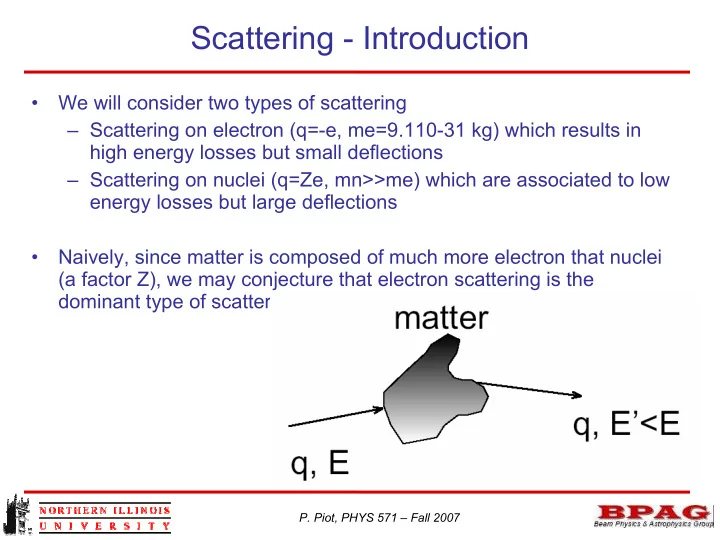

Scattering - Introduction • We will consider two types of scattering – Scattering on electron (q=-e, me=9.110-31 kg) which results in high energy losses but small deflections – Scattering on nuclei (q=Ze, mn>>me) which are associated to low energy losses but large deflections • Naively, since matter is composed of much more electron that nuclei (a factor Z), we may conjecture that electron scattering is the dominant type of scattering… P. Piot, PHYS 571 – Fall 2007
Energy transfer • We now are going to compute the energy transfer between two particle during scattering. • The technique is imply to consider the “matter” particle at rest and the particle to be scattered moving and penetrating the matter block. • Scattering is not a point like collision, it occur via long-range electromagnetic interaction (considering the e.m. field of the moving particle) P. Piot, PHYS 571 – Fall 2007
Energy transfer: the impulse approximation • Calculation of energy transfer in the most general case can be tedious, • So we make some simplifying assumptions: – Incident particle is NOT locally deflected by collision (rather a momentum kick is imparted and as the particle drifts away might be deflected) – Target particle is stationary during collision • These two assumptions are part of the “impulse approximation” (IA) incident target P. Piot, PHYS 571 – Fall 2007
Energy transfer: the impulse approximation • The E-field generated by the incident particle at the location of the target particle is • The momentum transfer from q to e is P. Piot, PHYS 571 – Fall 2007
Energy transfer: the impulse approximation NR • The associated kinetic energy change • The electrons • For nuclei • So we have P. Piot, PHYS 571 – Fall 2007
Energy transfer: the impulse approximation • Let’s what are the implication of the IA – Deflection angle is given by so – Target is stationary means that recoil of the target during collision is much smaller than impact parameter: d<<b • Interaction time during collision given by • The corresponding recoil is P. Piot, PHYS 571 – Fall 2007
Energy transfer: the impulse approximation • This is a stronger condition than the small deflection angle condition [by a factor M/m], so if the latter condition is fulfilled then the 1 st condition is fulfilled and IA is legitimate • So for IA to be valid we need Which can also be written ( β <1) • P. Piot, PHYS 571 – Fall 2007
NR approximation • NR approximation implies This is the SAME condition as for IA to be valid but just with γ → 1 • P. Piot, PHYS 571 – Fall 2007
Passage through a bulk of matter • Now we generalize our treatment to the case of a particle passing through a bulk of matter (many electrons). • We associate a electronic density n e to this block of matter • The total number of electron in a cylindrical shell or radius b is P. Piot, PHYS 571 – Fall 2007
Passage through a bulk of matter • The differential energy loss by the charge q is • Integrate over b P. Piot, PHYS 571 – Fall 2007
Passage through a bulk of matter • Limit of the integral – When b goes to zero IA is no more valid so we must limit our integral to values such that that is – When b goes to infinity the stationary condition breaks: electron orbit with an angular frequency so we must make sure P. Piot, PHYS 571 – Fall 2007
Passage through a bulk of matter • So finally • Since we have • Compare to Beth (1915) P. Piot, PHYS 571 – Fall 2007
Recommend
More recommend